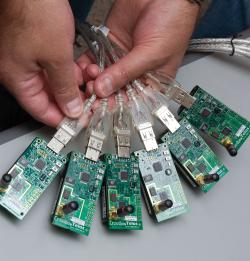XG - Next Generation Sensing and Communication
Contact: Leo de Vreede

The XG theme aims to pioneer the next generation of wireless sensing and communication systems with high functionality and low ecological footprint.

Motivation
The human desire for "smart environments" and "to be connected anywhere, anytime" is changing the way we interact with our surroundings and will drastically impact our society. Wireless data traffic is growing exponentially and is driving mobile networks and their devices from 4G+ to 5G services, to handle more users and services at higher data rates and lower latency. Consequently, the use of larger signal bandwidths and massive MIMO techniques will be mandatory. At the same time, the Internet-of-Things evolution will require connectivity of large numbers of devices at low data rates, but with very strict requirements on response times and energy usage. Spectrum scarcity will demand dynamic spectrum usage based on cooperative spectrum sensing and cognitive radio concepts. Moreover, GPS-free, reliable and accurate location estimation will prove to be an essential feature. While in the enhancement of societal safety and security (including environment monitoring and autonomous transportation), microwave and THz sensing systems are expected to play a crucial role.
XG Theme
The XG theme is a faculty-wide initiative combining expertise on electronics with that of networks and embedded systems. Within the theme, a number of societal applications are addressed:
- Autonomous driving - distributed sensing and high accuracy localization
- Wireless communication - 5G and beyond
- THz sensing
Technology
Wireless sensing and communication systems share the need to transmit and receive EM waves. This yields, in spite of their different signal processing, to similar requirements on system architecture and hardware technology. To serve both in a cost-effective and ecologically responsible manner, while benefiting directly from Moore’s law, novel reconfigurable highly integrated TX/RX solutions with multifunctional antenna systems and embedded signal processing capabilities are envisioned to be implemented in advanced semiconductor technologies. Cognitive/automated usage of EM spectrum, adaptive hardware and signal processing, cognitive sensing and network management are expected features of these next generation wireless systems.
Challenges
Scientific challenges are found in identifying and implementing new technology, design and system concepts that are truly energy-efficient, modular, data-rate scalable, frequency agile and cost-effective, while providing high functionality and data quality under intelligent control. These multidisciplinary challenges provide increased focus and synergy among the research groups within EEMCS that want to be leading in these developments and aim to provide the wireless communication and sensing solutions of the future.
Disciplines
Covered disciplines are electronics, digital, RF, (sub)mm-wave and THz circuit design, signal processing, cognitive/automated networking, embedded systems as well electromagnetics, antennas, remote sensing and space satellites applications.
Projects under this theme
Atmospheric Turbulence Informed Machine Learning for Laser Satellite Communications
Physics-informed machine learning algorithms to formulate the optical link performance map
Future Network Services 6G
Nationaal Groeifonds
Development of packaging technology at sub-terahertz frequencies
Towards Energy-Efficient Tbps Wireless Links
TeraGreen will develop ultra wideband and low-power consumption BiCMOS transmitters and receivers integrated with lens array architectures at 300GHz, combined with baseband algorithms suitable for energy-efficient analog-to-digital conversion.
Wideband wide-scanning arrays with improved polarization purity
Wideband wide-scan arrays for multifunction radars applications
Terahertz Integral Field Unit with Universal Nanotechnology
TIFUUN is an imaging spectrometer for mapping the submillimeter-wave universe in 3D
DIRAC
Communication technology unlocking the ocean – UCOMMS at the edge
Development of underwater communication techniques to improve the communication efficiency.
Next-generation chip assembly processes
Developing technology for ultra-high throughput and sustainable chip assembly processes.
Digital tRAnSmitTer ICs
This project aims to develop DTX ICs for highly-integrated and energy-efficient mMIMO base stations.
THz silicon-Integrated CAMera for low-cost imaging applications
Develop a real-time multi pixel passive radiometer, operating between 0.1 THz and 1THz, integrated in a silicon based technology, with temperature resolution better than 1K
Closed loop adaptive radar resource allocation
Design of a radar system to operate in a congested and contested environment
UNB-Lens-Arrays
Lens Antenna Array for Ultrafast Wireless Communication
Fundamentals of backside metals system for 5G RF power modules
Multi-Beam Antenna arrays
Wideband wide-scanning array with multi-beam capability
Terahertz Astronomy with Novel DiElectric Materials
Antenna user terminal with Wide Angle Impedance Matching (WAIM) metamaterial radome
Development of Satcom antenna for user terminals, with improved performances with respect to available phased array solutions.
Coded-Radar for Interference Suppression in Super-Dense Environments
CRUISE will address the challenges regarding spectrum crowding and ensures proper radar signal detection, accurate ranging, Doppler and azimuth measurements, and object classification in a highly-occupied frequency spectrum
Energy Efficient Radar TX
In the next years, advanced driver assistance systems (ADAS) are expected to transform cars into securely-connected self-driving robots with the capability of sensing the environment, thinking, and acting autonomously. CRUISE facilitates transforming to this near era.
Energy Efficient Wideband Transmitter, NXP Partnership ‘Advanced 5G Solutions’
This project providing enhanced average efficiency in wideband wireless transmitters while withstanding the changing load conditions that can occur in handheld devices and MIMO/smart-antenna communication systems.
Integrated Cooperative Automated Vehicles
This research program addresses current transportation challenges regarding throughput and safety with an integrated approach to automated and cooperative driving
Digitally Dominant Analog Blocks for Ultra-Low-Power Wireless Sensor Network
All-digital phase-locked loops, inductor/capacitor-based DC-DC switching converters
Smart Energy Efficient Digital Communication
SEEDCOM aims for fully integrated energy efficient wideband transmitters
smart Everything everywhere Access to content through Small cells Technologies
EAST is focused on the development of Small cell technologies for 5G applications up to 6 GHz
Standardized Self-diagnostic Sensing Systems for Highly Automated Driving
Deep Spectroscopic High-redshift Mapper
DESHIMA is an integrated superconducting spectrometer for wideband submillimeter astronomy
History
High Power RF-DAC
This project investigates the next generation of high power RF-DACs and digital intensive receivers
GaN-based PiN Diodes for RF Power Limiter Application
PIPP OLFAR: Breakthrough technologies for Interferometry in Space
Combine multiple satellites into one single scientific instrument: a radio telescope in space
Programmable Systems for Intelligence in Automobiles
(a) fail-operational sensor-fusion framework, (b) dependable embedded E/E architectures, (c) safety compliant integration of AI approaches for object recognition, scene understanding, and decision making
WAtt LEvel transmitters at mm-waves
The WhALE project targets, employing complementary expertise in the field of electromagnetics, system integration and integrated circuit design, to develop the next generation of mmwave transmitters.
High performance devices based on advanced materials
Artificial Dielectrics for High-frequency On-Chip antennas
Goal: To achieve optimized, reliable, flexible and low-cost manufacturing of the breakthrough technology of Artificial Dielectric (AD) layers, as the solution to the surface-wave problem of high-frequency on-chip antennas.
Task-cognizant sparse sensing for inference
Low-cost sparse sensing designed for specific tasks
STW Take-off phase1: High gamma vector network analysis
HΓ-VNA targets the implementation of a new measurement technique, enabling accurate characterization of electronic devices as well as biological and organic materials, which share the common characteristic of presenting extreme loading condition in the RF/Microwave frequency range.
Signal processing over wireless acoustic sensor networks
Microphone subset selection for WASNs
3D Elements For Phased Array Systems
The goal is to develop 3D antenna elements for phased arrays with integrated filtering solutions and suitable pattern shaping.
AlGaN/GaN High Electron Mobility Transistor (HEMT) Gas Sensor Platform Development
A Single-Photon, Time-Resolved Image Sensor for Low-Light-Level Vision
The project aims for a CMOS photon-counting image sensor with high timing resolution
SuperGPS: Accurate timing and positioning
Accurate timing and positioning through an optical-wireless distributed time and frequency reference
Efficient on-chip antennas for terahertz applications
Silicon technology promises affordable integrated THz systems, but at the cost of limited achievable efficiency. Antenna solutions to overcome this bottleneck efficiency will be investigated.
RESIST
Design approach for resilient integrated electronic systems in automotive and avionics applications
PulsarPlane: Worldwide Air Transport Operations
We investigate if pulsar navigation for aviation is positive, and analyse the impact on aviation.
Metrology for optical and RF communication systems
To develop traceable methods for RF power and MIMO antenna measurements and cost-effective metrological solutions for smart, adaptive, reconfigurable and wearable antennas.
Kinetic Inductance Detectors: a new imaging technology for observations in and from space
Imaging arrays of kinetic inductance detectors for space-based astronomical and earth observation applications
Ultra WideBand (UWB) Radio Indoor Positioning System
How can we accomplish effective, scalable and low-cost indoor positioning systems for practical applications using UWB radio signals?
Dotseven
DOTSEVEN is a very ambitious 3.5 year R&D project targeting the development of silicon germanium (SiGe) heterojunction bipolar transistor (HBT) technologies with cut-off frequencies (fmax) up to 700 GHz.
Sensing Heterogeneous Information Network Environment
How can heterogeneous resources (people, mobile sensors, fixed sensors, social media, information systems, etc.) self-organize for answering information needs?
Extreme Wireless Distributed Systems
EWiDS is one of the projects of the COMMIT program, concentrating on extreme wireless distributed systems. In EWiDS, we aim at a better understanding of using wireless, user-centric sensor technology to monitor and manage the behavior of people.
From RF to MMW and THz silicon SoC technologies
Silicon technology platforms for emerging RF, millimetre-wave and THz consumer applications.
Autonomous, self-learning, optimal and complete underwater systems
Can we develop robust, cooperative and cognitive communication for Autonomous Underwater Vehicles?
Reliable and fast wireless communication for lithography machines
Connecting a sensor network on a moving platform to a control unit; this requires high-speed links with low latency, and accurate wireless clock synchronization.
Separation of AIS Transponder Signals
AIS is a VHF communication system for ship transponders. Seen from a satellite, transponder messages overlap. The aim is to separate these using an antenna array.
Speech enhancement in wireless acoustic sensor networks
Distributed speech enhancement algorithms using a large number of microphones distributed in the environment
Low-frequency distributed radio telescope in space
Below 15 MHz, the ionosphere blocks EM signals from the sky. Therefore, can we design a radio telescope in space, using a swarm of inexpensive nano-satellites? Accurate localization and clock recovery is important.
Signal Processing for Self-Organizing Wireless Networks
Mathematical foundations to develop large self-organizing networks based on cognitive radio devices that are capable of sensing the radio spectrum and adapt accordingly.

